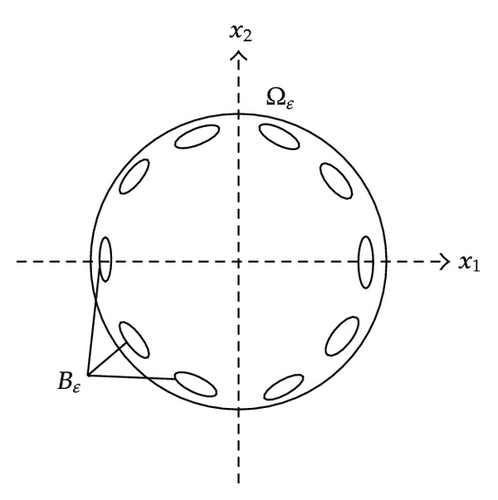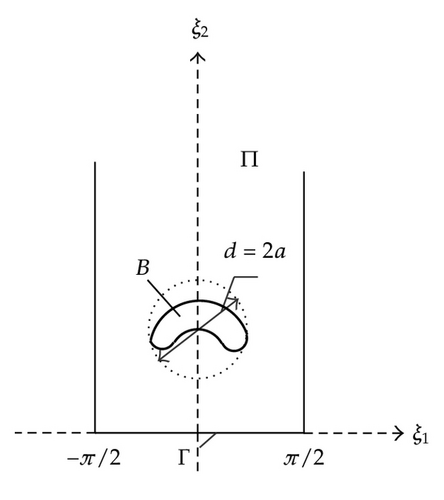On Spectrum of the Laplacian in a Circle Perforated along the Boundary: Application to a Friedrichs-Type Inequality
Abstract
In this paper, we construct and verify the asymptotic expansion for the spectrum of a boundary-value problem in a unit circle periodically perforated along the boundary. It is assumed that the size of perforation and the distance to the boundary of the circle are of the same smallness. As an application of the obtained results, the asymptotic behavior of the best constant in a Friedrichs-type inequality is investigated.
1. Introduction
We study a two-dimensional eigenvalue problem for the Laplace operator in a unit circle periodically perforated along the boundary. It is assumed that the size of perforation and the distance to the boundary of the circle are of the same smallness. The asymptotic behavior of the spectrum of the considered boundary-value problem is investigated in this paper. We construct and verify the asymptotic expansion for the eigenvalues with respect to the small parameter describing the microinhomogeneous structure of the domain. A similar problem was considered in [1] for the case of perforation located along the plane part of the boundary. The case studied in this paper is much more complicated since the eigenvalues of multiplicity more than one can appear. The technique for asymptotic analysis of such kind of problem can be found, for example, in [2, 3].
The obtained results are used for asymptotic expansion of the best constant in a Friedrichs-type inequality for functions from the space H1, vanishing on the boundary of the perforation and satisfying homogeneous Neuman condition on the boundary of the circle. Analogous questions concerning the asymptotic behavior of the best constant in Friedrichs-type inequality in domains having microinhomogeneous structure in a neighborhood of the boundary were studied in [1, 4–11]. In the remaining part of this introduction, we will give a short description of some of the most important results in these papers to put the results obtained in this paper into a more general frame.
In paper [4], the authors proved a Friedrichs-type inequality for functions, having zero trace on the small periodically alternating pieces of the boundary of a two-dimensional domain. The total measure of the set, where the function vanishes, tends to zero. It turns out that for this case the constant in the Friedrichs-type inequality is bounded. Moreover, the precise asymptotics of the constant in the derived Friedrichs-type inequality is described as the small parameter characterizing the microinhomogeneous structure of the boundary, tends to zero.
Paper [5] is devoted to the asymptotic analysis of functions depending on the small parameter, which characterizes the microinhomogeneous structure of the domain where the functions are defined. The authors considered a boundary-value problem in a two-dimensional domain perforated nonperiodically along the boundary in the case when the diameter of circles and the distance between them have the same order. In particular, it was proved that the Dirichlet problem is the limit for the original problem. Moreover, some numerical simulations were used to illustrate the results. As an application, a Friedrichs-type inequality was derived for functions vanishing on the boundary of the cavities. It was proved that the constant in the obtained inequality is close to the constant in the inequality for functions from . The three-dimensional case of the same problem is considered in [8].
In paper [9], the author considered a three-dimensional domain, which is aperiodically perforated along the boundary in the case when the diameter of the holes and the distance between them have the same order. A Friedrichs-type inequality was derived for functions from the space H1 vanishing on the boundaries of cavities. In particular, it was shown that the constant in the derived inequality tends to the constant of the classical inequality for functions from when the small parameter describing the size of perforation tends to zero.
Paper [1] (see also [7]) deals with the construction of the asymptotic expansion for the first eigenvalue of a boundary-value problem for the Laplacian in a perforated domain. This asymptotics gives an asymptotic expansion for the best constant in a corresponding Friedrichs-type inequality.
Paper [11], is devoted to the Friedrichs-type inequality, where the domain is periodically and rarely perforated along the boundary. It is assumed that the functions satisfy homogeneous Neumann boundary conditions on the outer boundary and that they vanish on the perforation. In particular, it is proved that the best constant in the inequality converges to the best constant in a Friedrichs-type inequality as the size of the perforation goes to zero much faster than the period of perforation. The limit Friedrichs-type inequality is valid for functions in the Sobolev space H1.
Some generalizations of Friedrichs-type inequalities are Hardy-type inequalities. There exist several books devoted to this topic, see [12–16]. The first attempts to generalize the classical results concerning Hardy-type inequalities in fixed domains to domains with microinhomogeneous structure one can find in [6, 10].
Paper [6] deals with a three-dimensional weighted Hardy-type inequality in the case when the domain Ω is bounded and has nontrivial microstructure. It is assumed that the small holes are distributed periodically along the boundary. The main result is the validity of a weighted Hardy-type inequality for the class of functions from the Sobolev space H1 having zero trace on the small holes under the assumption that a weight function decreases to zero in a neighborhood of the microinhomogenity on the boundary.
In paper [10], the author derived a new two-dimensional weighted Hardy-type inequality in a rectangle for the class of functions from the Sobolev space H1 vanishing on small alternating pieces of the boundary. The dependence of the best constant in the derived inequality on the small parameter describing the size of microinhomogenity was established.
This paper is organized as follows: in Section 2 we give all necessary definitions and state the spectral problem. Section 3 is devoted to the construction of the leading terms of asymptotic expansion, while the complete expansions for the simple and multiple eigenvalues are constructed in Sections 4 and 5, respectively. The verification of the constructed asymptotics is given in Section 6. Finally, in Section 7, the obtained results are applied to describe the asymptotic behavior for the best constant in a Friederichs-type inequality considered in a perforated domain.
2. Preliminaries


Remark 2.1. In particular, it can be proved that the number of eigenvalues (bearing in mind the multiplicities) of the original problem converging to the eigenvalue of the limit (homogenized) problem is equal to the multiplicity of the mentioned eigenvalue of the limit problem (for the method of proof see, e.g., [19]).
Remark 2.2. The limit spectral problem (2.3) is studied very well. In particular, if the eigenvalue λ0 is simple, then the corresponding eigenfrequency of (2.3) is the zero-point of the Bessel-function 𝒥0, and the corresponding eigenfunction has the form 𝒥0(k0r). One can find the definition of Bessel-functions, for example, in [20, Section 4.7].
3. Construction of the Leading Terms of the Asymptotic Expansion
Proposition 3.1. For any λ1, there exists the smooth solution of (3.3) satisfying the boundary condition
Proof. The existence of the smooth solution follows from the classical results on regular solutions of elliptic equations (see e.g., [22]). In order to get u1 as the unique solution, one can add the condition of mutual orthogonality:
By multiplying (3.3) by u0, integrating (3.3) over Ω, and twice integrating by parts the obtained equation, we find that
The following lemma gives the conditions to obtain v as an exponentially decaying function as ξ2 → ∞.
Lemma 3.2. Assume that F is π-periodic with respect to ξ1 function with exponential decay as ξ2 → ∞, and let v be a π-periodic solution of the boundary-value problem:
Proof. The existence of the solution with asymptotics follows from the classical results on elliptic boundary-value problems in cylindric domains (see, e.g., [23] and [24, Chapters 2, 5]). Let us verify (3.20). Define ΠR = Π∩{0 < ξ2 < R} and ΓR = {ξ : −π/2 < ξ1 < π/2, ξ2 = R}. By multiplying the equation from (3.15) by Y, integrating it over , and using the property of Y, we get that
4. Complete Expansion in the Case of the Simple Eigenvalue λ0
Lemma 4.1. Suppose that F and v satisfy the conditions of Lemma 3.2. (a) If F is even with respect to ξ1, then v is even; (b) if F is odd with respect to ξ1 and A1 = A2 = 0, then v is odd with respect to ξ1 and decays exponentially as ξ2 → ∞.
Theorem 4.2. There exist numbers ki and π-periodic in ξ1 functions vi with finite Dirichlet integral in Π and exponential decay as ξ2 → ∞, such that these functions are solutions of the following boundary-value problems:
Proof. Let v be the solution of boundary-value problem (3.15). It can be easily verified that
Theorem 4.2 implies the validity of the following useful result.
Theorem 4.3. For any integer N > 0, the function uɛ,N is the solution of the boundary-value problem
Proof. According to the definition of uɛ,N, we have that
By using the fact that lim x→∞xe−αx = 0 and due to the result of Theorem 4.2, we have that, for any 1 ≤ i ≤ N,
According to the definition of χ, the support of ∇xχ and Δxχ is the set {1/4 ≤ r ≤ 1/2}. Summarizing, we have that
5. Complete Expansion in the Case of Multiple Eigenvalue λ0
Theorem 5.1. There exist numbers ki and π-periodic in ξ1 even functions and odd functions with finite Dirichlet integral in Π, which have exponential decay as ξ2 → ∞, such that these functions are solutions of the boundary-value problems (5.8), (5.4), (5.5), and (5.9), (5.7), respectively. Moreover, the constants ki are defined by the formula:
Proof. The problems (5.8), (5.5), (5.4) for functions coincide with problems (4.22), (4.17), and (4.20) (if one change by and fi, gi by the respective ). Therefore the construction of and k1, k2 is just the same as the construction from the proof of Theorem 4.2. Due to (5.9), (5.7), the problem for is as follows:
Theorem 5.1 implies the validity of the following result.
Theorem 5.2. For any integer N > 0, the function uɛ,N is the solution of the boundary-value problem:
Proof. The proof is analogous to the proof of Theorem 4.3. Hence, we omit the details.
6. Verification of the Asymptotics
7. Application to a Friedrichs-Type Inequality
Consider the sets Ωɛ, Γɛ, which were defined in Section 2.
Definition 7.1. The Sobolev class H1(Ωɛ, Γɛ) is the class of functions from H1(Ωɛ) having zero trace on Γɛ.
Theorem 7.2. Let u ∈ H1(Ωɛ, Γɛ). Then a Friedrichs-type inequality
Proof. The geometric approach developed in [5, 9] allows us to state that there is a constant K > 0 such that
Acknowledgments
This paper was completed during the stay of the second author as PostDoc at Luleå University of Technology in 2010-2011. The second author wants to express many thanks to Luleå University of Technology (Sweden) for financial support and wonderful conditions to work. The work of the first and the second authors was supported in part by RFBR (Project no. 09-01-00353) and the work of the forth author was supported by a grant from the Swedish Research Council (Project no. 621-2008-5186). The authors also thank referee for several suggestions, which have improved the final version of this paper.




